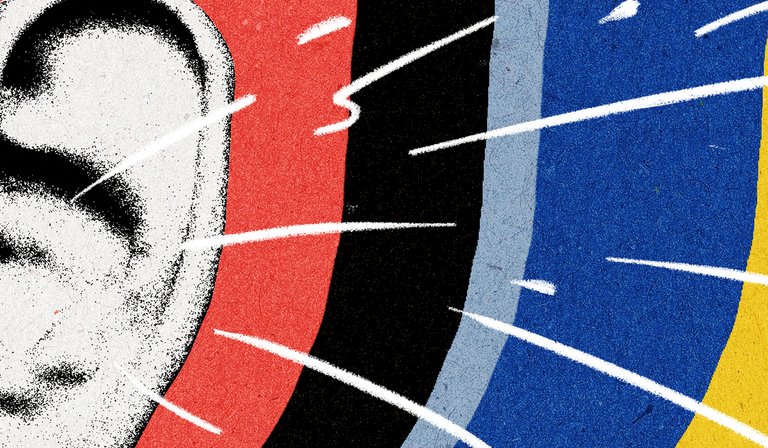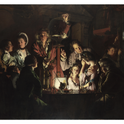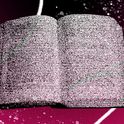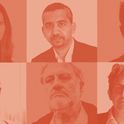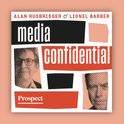The language we use reveals an awful lot about what our society deems important. In The Quiet Ear, Raymond Antrobus writes that, alongside the primary definition of “sound”, which refers to the sensation of hearing, comes an altogether different meaning: “to arrive somewhere ‘safe and sound’ is to be settled; to be ‘sound’ is to be thorough, well-balanced, well-adjusted”. So what does that make someone who doesn’t hear all sounds? Elsewhere, he references the British artist Aaron Williamson who, confused by the term “hearing loss”, coined a new one: “Deaf gain”.
Such inquiries into the subtlety of language come naturally to Antrobus, a celebrated poet. His debut collection, The Perseverance, was published in 2018. Two further poetry books, All the Names Given and Signs, Music, as well as two children’s stories, have followed. With them, Antrobus has won a plethora of literary prizes, while his poem “Jamaican British”, a broken ghazal that incisively explores what it is to be mixed race yet belonging to neither ethnic group, now sits on the GCSE syllabus.
The Quiet Ear is Antrobus’s first work of prose. A memoir recounting his childhood and adolescence after he was diagnosed with deafness aged six, the book is subtitled “An Investigation of Missing Sound”, as he upturns the assumption that to be deaf is to simply not have a relationship with sound. In the book’s introduction, he asserts that he found the act of examining this part of himself “liberating”, though the associated losses are many: “Missing sound can also be interpreted as a misunderstanding, a mismanaged sense of self, a miseducation, a miscellaneous shelf in a mystery library,” he writes, typically exploratively.
Soon after Antrobus was born in Homerton Hospital, east London, in 1986, a midwife clicked her fingers next to his ears and judged his response. “It was my first hearing test, and I passed,” he writes, with more than a hint of irony. For the next six years, it was assumed he was “just slow or perhaps dyslexic”. He would often get into trouble at school because he would miss parts of teachers’ instructions. Still a young child, he found himself feeling more and more untethered to reality. “I was constantly told that what I was hearing was wrong without understanding why, which meant I couldn’t trust myself or the world around me.”
It wasn’t until his mother bought a “large, exceptionally loud, cream-coloured telephone that sat in her living room like a pet” and watched as her son was unresponsive when it rang, that he was diagnosed as deaf. Describing his first time wearing hearing aids, leaving the doctor’s clinic and walking out onto the London streets, Antrobus “noticed that everything had language. The door gasped when it opened. The street flashed and blared.” It was overwhelming. What he newly heard around himself “felt harsh and treacherous, like a metal world full of stiff, inescapable crushing machines”. Still so young to have this revelation, he turned to his mother: “‘Life?’ I asked. ‘Is it this loud?’” This contrast between vivid, image-filled descriptions and the naivety of childhood occurs frequently in The Quiet Ear, resulting in a book as surprising as it is heartfelt.
Antrobus has ski-slope deafness, meaning his “missing sounds” are those of higher frequencies. Sounds such as “th”, “ch” and “fa” elude him, as do words with silent letters—“lasagne”, “ballet”, “aisle”. These words “had a sound that would never be mine”, he writes. “I will always be speaking at the edge of them.” Antrobus uses his own story and that of other D/deaf artists and thinkers (“Deaf” represents culturally Deaf signing people, while “deaf” refers to deafened people who use speech) to explore the many variations in the D/deaf experience, navigating the prejudices that exist both in hearing cultures (while still at school, one friend’s mother told him she thought his mother was “overreacting by giving me hearing aids because I didn’t seem deaf enough”) and within the Deaf community (which does not always fully embrace him because he lip-reads rather than speaking with British Sign Language).
Born to an English mother and Jamaican father, Antrobus also found himself at another identity intersection: race. “I picked up on the anxiety my racial ambiguity caused others and played into whatever perception kept me safest; black, white, whatever they wanted to see.” His deafness was a source of trouble for his father, a music-loving Rastafarian, who separated from his mother early on but continued living locally. He drank heavily, calling Antrobus “white”—an insult—when he was drunk, and “black” when he was sober. Every time his son’s deafness was mentioned, he brought up a story about Calvin, a “developmentally slow” boy he had known at school, whom the teachers beat so often the students turned on him too. One day another boy walked up to Calvin and stabbed him with a sharpened pencil in each ear. He bled from both sides of his face and never returned to the school. This “trauma” was Antrobus’s father’s “only association with what deafness is”, the author writes. “Something that makes you disappear.”
There are now more school-age deaf children than when Antrobus was young, yet fewer deaf schools
Antrobus had other more supportive adults around him, not least his mother, as well as a series of speech and language therapists and teachers at the deaf school he attended. (He notes how lucky he was to even attend a specialist setting: there are now more school-age deaf children in England than when he was young, yet fewer deaf schools.) He writes movingly about Mark, a particularly encouraging swimming instructor, and the freedom that being in the pool brought: “We are all deaf underwater to a certain extent. I felt liberated beneath the surface, the warbling, smeary underwater incoherence, the soft crashing of other bodies joining you in the water…” His reflections on music—anchored by the words of the Scottish percussionist Evelyn Glennie, who has noted that “most deaf people do not live in a world of silence” and can therefore enjoy music—are similarly profound.
But “deaf shame” followed him. As a child, Antrobus refused sign language and pretended to hear when he couldn’t. Even though he wore hearing aids every day, he wouldn’t ever include them when drawing pictures of himself. “My superpower became lip-reading and perfecting my listening face, so it looks like I’m fluidly following speech, nodding, relaxing my shoulders, loosening my jaw,” he writes, uncovering his secret. But become too good at that, and people don’t believe you’re really deaf, like that mother of a school friend. How can you win?
In the worst circumstances, this societal misunderstanding of deafness leads to tragedy. Antrobus recounts the story of Tyrone Givans, a black boy who attended the same deaf school as him. After leaving school, Givans struggled with alcoholism and ended up in prison on domestic abuse charges. Arrested without his hearing aids, he pleaded for them but was not given them because “he seemed to communicate fine without them”. He hanged himself in his cell.
The Quiet Ear also tracks the early days of Antrobus’s poetry career, when he would turn up early to gigs in order to walk around a venue and work out where was best to stand. He still sometimes was unable to hear the poet reading aloud, yet nonetheless felt he ought to laugh whenever people around him did. He skewers Ted Hughes’s poem “Deaf School”, in which the former poet laureate used animal metaphors to describe a class of deaf children, calling them “simple”. Antrobus’s rebuke—a version of Hughes’s poem where the verse is totally redacted with thick black markings—was included in The Perseverance, for which, quite brilliantly, he won the Ted Hughes award. Yet, even then, he found some wanted him to be a certain kind of D/deaf person. When he took a call from a BBC journalist for a live radio interview following the award, he was asked: “It’s my understanding that you’re deaf, so how are you able to talk to me now?”
The book follows a non-linear structure, as has become popular for nonfiction and particularly memoir. It allows Antrobus to flip easily back in time to poignant moments from his childhood, and even to family history that occurred before his birth, then fast-forward to his present life as a poet, educator and father of a son. Antrobus is a perceptive chronicler of our society’s narrow-mindedness, and the more lyrical sections of the book make this chronicling especially vivid.
But it’s far from a perfect memoir. Occasionally, chapters feel jolty—and lose their implied meaning—as Antrobus moves too quickly between academic-seeming writing and his own past experience, then on to the present day and back again. Elsewhere, some sections don’t fit within their chapter or offer a new perspective on what has just been raised; a few paragraphs on Hashem Ghazal, a Palestinian teacher of the deaf, for example, feel unnecessarily tacked on to an otherwise discrete section and would have greater impact if more fully fleshed out.
But you get the sense that Antrobus is not seeking perfection. After all, this frank, poetic treatise on D/deafness is about disputing society’s too often reductive view on how a disability should define a person. The reality, Antrobus knows, is far more complicated.
